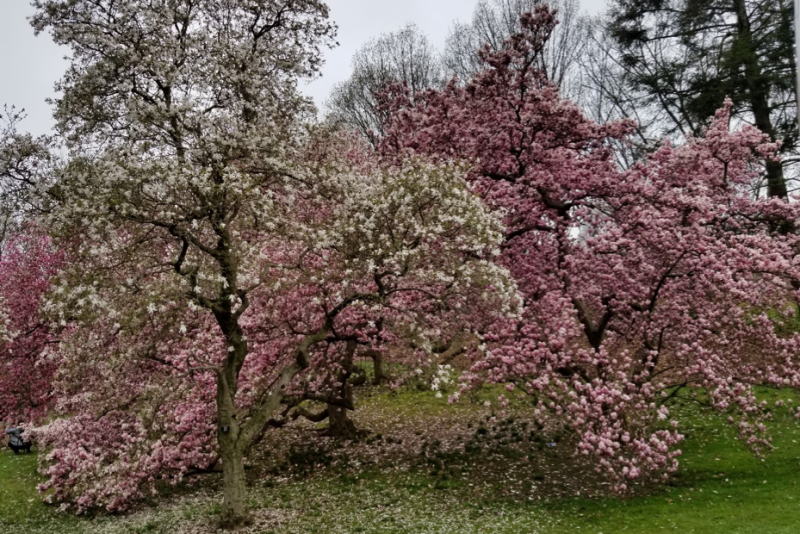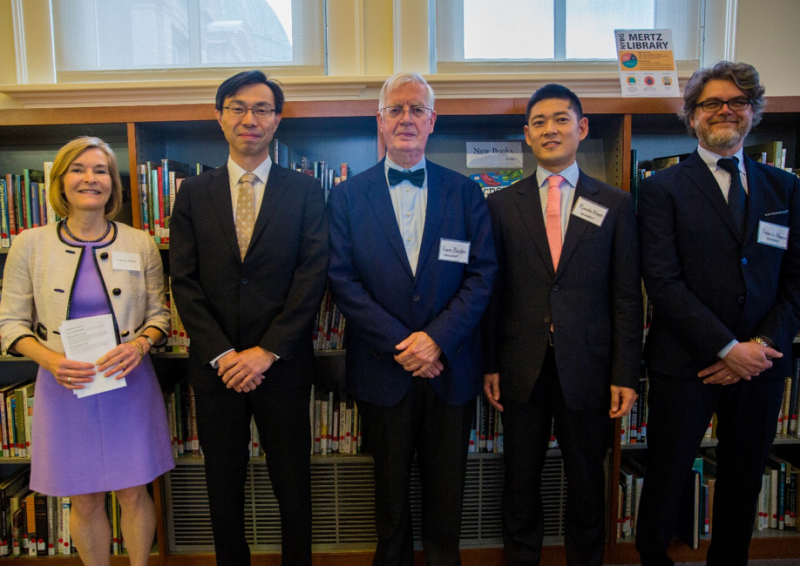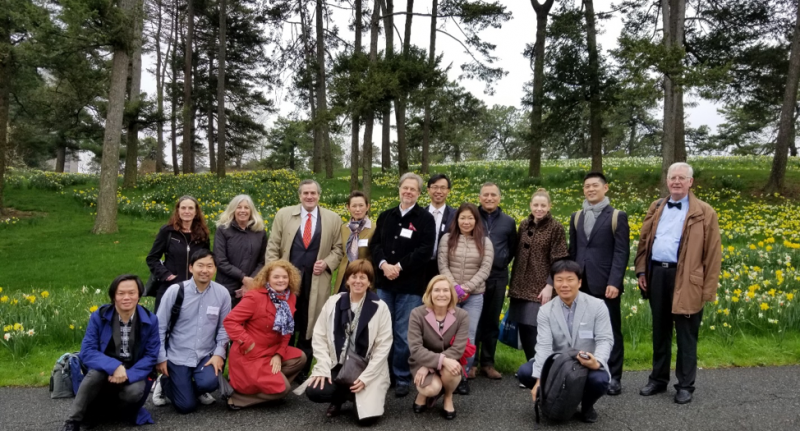Japan Study Day at NYBG
Posted in Humanities Institute on August 16 2018, by Mertz Library

On April 27, 2018 the Humanities Institute hosted Japan Study Day, a day of celebrating Japanese arts and sciences in the field of natural history and garden design. Visitors were welcomed with a soft misty rain, here and there mixed with a few pink petals, as they entered the Garden that morning. Due to the unusually cold spring, the Cherry Trees happened to be at their peak bloom. It was a perfect day for the traditional celebration of ‘Sakura,’ the flowering of the Cherry Trees. Japan Study Day participants were invited to join a conversation led by a brilliant panel of speakers from around the globe. Leading the conversation was Prof. Federico Marcon, Department of East Asian Studies, Princeton University; Prof. Harmen Beukers from the Scaliger Institute, Leiden, the Netherlands and the University of Nagasaki; and Ryosuke Kondo, Ph.D. candidate from the Department of Landscape Architecture, Tokyo University.
Those present for the day’s festivities were students, researchers, historians, landscape design professionals, museums curators and scholars of Asian art and culture. Also present, were several officials of the Japan Society of New York, and diplomatic representatives from the Consulate General of Japan and The Netherlands. All gathered in the LuEsther T. Mertz Library for a warm welcome from the Humanities Institute’s Coordinator, Vanessa Bezemer Sellers. The Deputy Consul General of the Japan Information Center, Consulate General of Japan, Mr. Sato officially opened Japan Study Day with a special dedication to his colleague, Joost Taverne, Cultural Attaché, Head of Press and Cultural Affairs, Consulate General of The Netherlands. The dedication was made in acknowledgement of the two countries shared history and cultural-scientific exchange via Deshima, the Dutch trading post off the coast of Nagasaki, during the long period of Japan’s isolation (1641-1859).

The first speaker, Prof. Federico Marcon, recounted the surprising popular appeal of plants and animals in early modern Japan illustrated by prints of public and private collections throughout the archipelago, from teahouses filled with curiosa to societies and clubs where one specialized in the study of nature (honzogaku). “However, until the mid-19th century, only a spare few botanical scholars were permitted access to Japan to study its plant life or animals,” added Prof. Harm Beukers, the second speaker. “One of those lucky ones, was Philipp Franz von Siebold, who cultivated his own botanical garden, arranged an entire reference library of Japanese books, and after publishing a new Flora Japonica, established the Netherlands Society for Horticulture in 1842, an institute that would set the stage for Holland as premier horticultural center.” The third and final presentation, entitled Sakura to Akebono-sugi: Trees in Japanese Urban Landscape Design, incorporated several remarkable historical movie clips to underscore the last speaker, Ryosuke Kondo’s well-chosen arguments. “Sakura, or cherry blossom tree, has played a vital role in Japanese culture since the 8th-century,” he said, “with its blossoms symbolizing everything from private love to imperial might.” “It is important, however, to stress the importance of another, under-recognized strain of Japanese tree – the Akebono-sugi, or dawn redwood,” Kondo urged. Assumed extinct, but discovered alive and well in China in the 1940’s and further identified by Japanese botanist Shigeru Miki, this tree now shapes the urban landscapes and gardens across Japan. A sapling was presented to the Emperor Showa by American paleontologist Ralph W. Chaney in 1949, and seeds from the tree subsequently sent to the New York Botanical Garden, where they now thrive in the Benenson Ornamental Conifer collection, near the Nolen Greenhouse.

After enjoying a display of rare Japanese print works furthering the science and art of Japan’s natural history and gardening, the audience left with much to think about and ready to tour the Garden to see the Sakura trees. Each speaker in their own unique way, had opened a window into the history of Japan’s relationship with its natural environment; its botanical-medical expertise, and Japan’s legendary traditional affection for trees and gardens A letter sent by one of the participants, a teacher at the World View High School, expressed how much she and her students had enjoyed the special Japan Day:
“It was an honor to be in the same room with many Japanese history and botany enthusiasts and scholars. We loved the lectures … My students left with a greater appreciation and interest in Japanese history and culture … It was also very exciting to see the Akebono Sugi (Dawn Redwood) at the NYBG along with the beautiful cherry blossom trees. My students and I forgot that we were still in the Bronx, just a train stop away from our school.”

